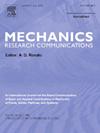奇物质的热力学基础
IF 2.3
4区 工程技术
Q3 MECHANICS
引用次数: 0
摘要
奇物质的连续型本构关系需要根据热力学第二定律来表述。根据爱德伦(1973-1974)的原始热力学,概述了导热流体和导热固体的一个程序,它承认最一般的关系。对于奇物质的粘性响应,该理论除了考虑超耗散力外,还考虑了不可逆力和非耗散力。对于准静态响应,除了由自由能导出的力外,还掌握了弹性力和非保守力,这是超弹性之外的柯西弹性领域。所得的本构关系满足材料框架无关原则和角动量守恒原则。奇流力学在层流中的两个应用表明,速度场不变,应力场随奇粘度的变化而改变。在coserat型奇物质中,除了分别考虑变形张量和力-应力张量外,原始热力学还考虑了曲率-扭转和耦合-应力。在经典和微极两种情况下,该理论都掌握了热力学速度和力矢量之间所有可能的耦合,以及超耗散和超弹性响应(线性和非线性)的全范围各向异性。本文章由计算机程序翻译,如有差异,请以英文原文为准。
Thermodynamic basis for odd matter
Continuum-type constitutive relations of odd matter need to be formulated according to the second law of thermodynamics. Based on the primitive thermodynamics of Edelen (1973-1974), a procedure admitting most general relations, is outlined for heat-conducting fluids and solids. For viscous responses of odd matter, the theory accounts for the irreversible and non-dissipative forces, besides the hyperdissipative ones. For quasi-static responses, the theory grasps the elastic and non-conservative forces besides those derivable from the free energy, this being the realm of Cauchy elasticity beyond hyperelasticity. The obtained constitutive relations satisfy the principle of material frame-indifference and the angular momentum conservation. Two applications of odd fluid mechanics in laminar flow show the velocity fields to be unchanged, with the stress fields altered by the odd viscosity. In Cosserat-type odd matter, primitive thermodynamics also accounts for curvature-torsion and couple-stress besides, respectively, deformation and force-stress tensors. In both, classical and micropolar cases, the theory grasps all possible couplings between the thermodynamic velocity and force vectors, along with a full range of anisotropies of hyperdissipative and hyperelastic responses (both linear and nonlinear).
求助全文
通过发布文献求助,成功后即可免费获取论文全文。
去求助
来源期刊
CiteScore
4.10
自引率
4.20%
发文量
114
审稿时长
9 months
期刊介绍:
Mechanics Research Communications publishes, as rapidly as possible, peer-reviewed manuscripts of high standards but restricted length. It aims to provide:
• a fast means of communication
• an exchange of ideas among workers in mechanics
• an effective method of bringing new results quickly to the public
• an informal vehicle for the discussion
• of ideas that may still be in the formative stages
The field of Mechanics will be understood to encompass the behavior of continua, fluids, solids, particles and their mixtures. Submissions must contain a strong, novel contribution to the field of mechanics, and ideally should be focused on current issues in the field involving theoretical, experimental and/or applied research, preferably within the broad expertise encompassed by the Board of Associate Editors. Deviations from these areas should be discussed in advance with the Editor-in-Chief.

 求助内容:
求助内容: 应助结果提醒方式:
应助结果提醒方式:


